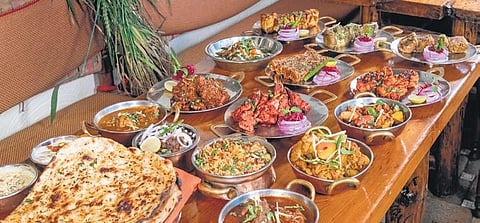

India is a culturally rich country that boasts varied cuisine and a host of festivities. That, however, has not discouraged the country from embracing healthy and conscious eating—post the pandemic, everyone is wary about calorie intake and is ensuring health-meets-flavour even while enjoying the festive fare.
As the entire region of Delhi-NCR enjoys Baisakhi—the harvest festival—with great enthusiasm and fervour, citizens are also looking to be mindful of their food choices. Mahavir Singh, Head Chef, Dhaba at The Claridges, Delhi—he has curated a unique menu that features dishes such as bhatti ka murg, paneer de tikka, and aloo choliya (green chickpeas)—shares, “The fusion of wholesome vegetables and spices characterises traditional Indian cuisine. Using artisanal and natural ingredients is recommended to enhance the nutritional value of the traditional dishes. Furthermore, one can add seasonal vegetables that are a rich source of nutrition and antioxidants.”
Good food meets nutrition
The food served during Baisakhi is a delightful blend of flavours and aromas that truly represents the essence of the festival. From the traditional sarson da saag and makki di roti to the mouth-watering paneer tikka and tandoori chicken, Punjabi cuisine is an amalgamation of vegetarian and non-vegetarian delicacies that can tantalise every taste bud. Sumit Sabharwal, executive chef, Holiday Inn, Aerocity, says, “During this time, there are many nutritious foods that can be added to the diet. For instance, we make makki di roti and sarson da saag, which are very healthy. Another popular dish is Amritsari chole kulche.”
One of the significant aspects of Baisakhi food is that the food is prepared with fresh ingredients that are locally sourced, making it not just delicious but also packed with essential nutrients that provide health benefits. Sabharwal shares that paneer is a rich source of protein that can be enjoyed with corn meal, wheat flour, chickpeas, or chole. Singh adds, “Fresh choliya (green chickpeas) is a commonly found ingredient in rural India, but its nutritional content is often overlooked. It is actually a rich source of protein and vitamins.” This, as Singh suggests, can be used to craft dishes. One can also take special care to maintain the cooking process of these dishes to preserve their nutritional value, he adds.
Avoiding too many spices is a good start, shares Sabharwal, “Avoid adding too much masala. For kulche, use wheat flour instead of oil. One can also cook it in a clay oven for a wholesome taste. A paneer dish is also an excellent option that can be cooked with minimal spices.”
Satisfy your sweet tooth
Apart from the traditional Punjabi cuisine, this is also a time when looks forward to indulging in sweets. Gulab jamun, rasgulla, and jalebi, which are high in sugar and calories, can be enjoyed in moderation. But there are alternatives as well. “For sweets, I suggest a preparation called meethe peele chawal—it requires rice, saffron, and cardamom and is a delicious dessert.” concludes Sabharwal.